Consider two countries (Russia and India) that can produce two goods (Books and Automobiles) using two factors of production (Economists and Workers). Assume the regular assumptions of the Factor Proportions model apply and that factor endowments between the two countries are given by: Russia India Economists 240 80 Workers 12,360 2,480 Also assume that average factor requirements for Books and Automobiles (in both Russia and India) are such that Books are Economist-intensive while Automobiles are Worker-intensive. (a) Which country has a comparative advantage in which good? What will be the pattern of trade. Explain. (b) Demonstrate your answer to (a) by drawing PPF's and price lines (both autarky and world) for both Russia and India (place auto's on the x-axis). On each picture label the autarky production/consumption point A, the production point after trade B and the consumption point after trade C (note: you cannot solve for any of these points. I will just be checking that your pictures and where you place these points are consistent with the answer to (a). (c) Will Economists in the Automobile industry in India benefit or be hurt by trade with India in the short run? Explain. (d) Will Economists in the Automobile industry in India benefit or be hurt by trade with India in the long-run? Explain.
Consider two countries (Russia and India) that can produce two goods (Books and Automobiles) using two factors of production (Economists and Workers). Assume the regular assumptions of the Factor Proportions model apply and that factor endowments between the two countries are given by: Russia India Economists 240 80 Workers 12,360 2,480 Also assume that average factor requirements for Books and Automobiles (in both Russia and India) are such that Books are Economist-intensive while Automobiles are Worker-intensive. (a) Which country has a comparative advantage in which good? What will be the pattern of trade. Explain. (b) Demonstrate your answer to (a) by drawing PPF's and price lines (both autarky and world) for both Russia and India (place auto's on the x-axis). On each picture label the autarky production/consumption point A, the production point after trade B and the consumption point after trade C (note: you cannot solve for any of these points. I will just be checking that your pictures and where you place these points are consistent with the answer to (a). (c) Will Economists in the Automobile industry in India benefit or be hurt by trade with India in the short run? Explain. (d) Will Economists in the Automobile industry in India benefit or be hurt by trade with India in the long-run? Explain.
Chapter13: General Equilibrium And Welfare
Section: Chapter Questions
Problem 13.3P
Related questions
Question
2.
can you explain how you find out each part?

Transcribed Image Text:Consider two countries (Russia and India) that can produce two goods (Books and Automobiles)
using two factors of production (Economists and Workers). Assume the regular assumptions of
the Factor Proportions model apply and that factor endowments between the two countries are
given by:
Russia
India
Economists
240
80
Workers
12,360
2.480
Also assume that average factor requirements for Books and Automobiles (in both Russia and
India) are such that Books are Economist-intensive while Automobiles are Worker-intensive.
(a) Which country has a comparative advantage in which good? What will be the pattern of
trade. Explain.
(b) Demonstrate your answer to (a) by drawing PPF's and price lines (both autarky and world)
for both Russia and India (place auto's on the x-axis). On each picture label the autarky
production/consumption point A, the production point after trade B and the consumption point
after trade C (note: you cannot solve for any of these points. I will just be checking that your
pictures and where you place these points are consistent with the answer to (a)).
(c) Will Economists in the Automobile industry in India benefit or be hurt by trade with India in
the short run? Explain.
(d) Will Economists in the Automobile industry in India benefit or be hurt by trade with India in
the long-run? Explain.
Expert Solution
This question has been solved!
Explore an expertly crafted, step-by-step solution for a thorough understanding of key concepts.
This is a popular solution!
Trending now
This is a popular solution!
Step by step
Solved in 4 steps with 2 images

Recommended textbooks for you

